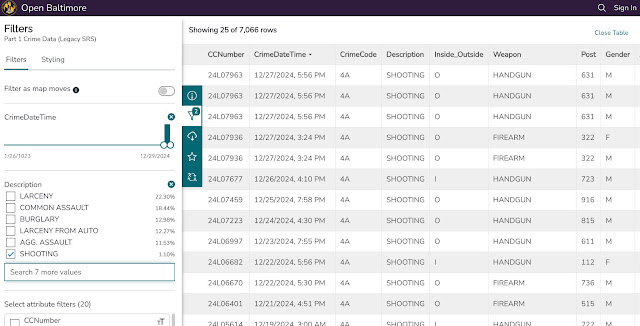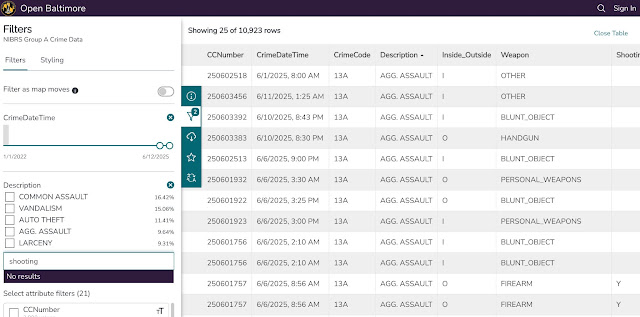Baltimore Says Shootings Are Down. But Their New Crime Feed Makes It Harder to See Them
In 2025, the Baltimore Police Department updated its public crime data, switching from the old UCR Part I system to the more detailed NIBRS (National Incident-Based Reporting System). The change was part of a national push for more comprehensive crime reporting. But in Baltimore’s case, one critical data point has effectively vanished from public view: shootings.
In 2024, Shootings Were Easy to Find
Even though “shooting” isn’t a standard UCR Part I crime type, Baltimore took the extra step of listing it as a distinct incident category in its 2024 public data feed. That decision gave residents, journalists, researchers, and advocates a powerful tool to track gun violence directly. No guesswork or complicated filtering required.

It was a simple but effective act of transparency. But now it’s gone.
In 2025, the Shooting Category Vanishes
The 2025 NIBRS-format feed dropped the Shooting category, making it hard to track shootings. The public-facing feed no longer includes a clear way to filter or map actual shootings, despite the increased detail NIBRS is supposed to offer.
In 2024, Shootings Were Easy to Find
Even though “shooting” isn’t a standard UCR Part I crime type, Baltimore took the extra step of listing it as a distinct incident category in its 2024 public data feed. That decision gave residents, journalists, researchers, and advocates a powerful tool to track gun violence directly. No guesswork or complicated filtering required.
It was a simple but effective act of transparency. But now it’s gone.
In 2025, the Shooting Category Vanishes
The 2025 NIBRS-format feed dropped the Shooting category, making it hard to track shootings. The public-facing feed no longer includes a clear way to filter or map actual shootings, despite the increased detail NIBRS is supposed to offer.
They do still include the “Weapon” field, but it creates ambiguity. Instead of seeing Description: Shooting, Weapon: Handgun (or firearm), you’ll now see Description: Aggravated Assault, Weapon: Handgun (or Firearm).

But here’s the problem: these labels are vague. Does “Aggravated Assault – Handgun” mean someone fired a gun? Could it also mean a gun was brandished or used to pistol-whip someone? How do we distinguish non-fatal shootings from threats or physical assaults involving firearms?
But here’s the problem: these labels are vague. Does “Aggravated Assault – Handgun” mean someone fired a gun? Could it also mean a gun was brandished or used to pistol-whip someone? How do we distinguish non-fatal shootings from threats or physical assaults involving firearms?
Meanwhile, Officials Are Touting a Drop in Shootings
According to news reports, Baltimore officials are celebrating a drop in gun violence and shootings in 2025. If true, that’s great news.
According to news reports, Baltimore officials are celebrating a drop in gun violence and shootings in 2025. If true, that’s great news.
But the timing is hard to ignore. Just as the city promotes these successes, the most direct method of verifying those claims in the public data has been removed.
That raises serious questions. Is the drop in shootings real—or the result of changing how the data is reported? Was the removal of the "Shooting" category intentional, or an oversight? Why wasn’t this change communicated more clearly to the public and data users?
We’ve gone from “Shooting” as a clear incident type to ambiguous weapon labels. That’s not progress in transparency. That’s a step backward.
Oversight or Obfuscation?
Our hope is that this was unintentional. Maybe the data team didn’t realize how valuable that standalone “Shooting” label was. But the outcome is clear - Baltimore’s “more detailed” crime data now makes it harder to understand one of the city’s most urgent public safety issues.
Our hope is that this was unintentional. Maybe the data team didn’t realize how valuable that standalone “Shooting” label was. But the outcome is clear - Baltimore’s “more detailed” crime data now makes it harder to understand one of the city’s most urgent public safety issues.
Why It Matters
This isn’t just a formatting issue. It’s about public trust. If shootings are truly down, Baltimore should want to prove that clearly. Removing the ability to track gun violence just as the city claims victory over it undermines confidence in those claims.
This isn’t just a formatting issue. It’s about public trust. If shootings are truly down, Baltimore should want to prove that clearly. Removing the ability to track gun violence just as the city claims victory over it undermines confidence in those claims.
When cities migrate to new data systems, they have a responsibility not just to publish data, but to preserve public accessibility and understanding. Losing the ability to trace shootings in a city battling gun violence is not a small detail. It’s a serious setback.
Gun violence is one of the most important public safety indicators for residents, reporters, policymakers, and researchers. Removing the ability to track it transparently, especially while publicly claiming victories against it, undermines the entire point of open data. If shootings are really down, Baltimore should want to prove it clearly and openly. Instead, it feels like the data needed to check those claims was quietly buried during a system upgrade.



Comments